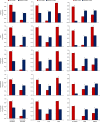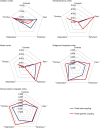Thalamocortical dysrhythmia detected by machine learning
- PMID: 29549239
- PMCID: PMC5856824
- DOI: 10.1038/s41467-018-02820-0
Thalamocortical dysrhythmia detected by machine learning
Abstract
Thalamocortical dysrhythmia (TCD) is a model proposed to explain divergent neurological disorders. It is characterized by a common oscillatory pattern in which resting-state alpha activity is replaced by cross-frequency coupling of low- and high-frequency oscillations. We undertook a data-driven approach using support vector machine learning for analyzing resting-state electroencephalography oscillatory patterns in patients with Parkinson's disease, neuropathic pain, tinnitus, and depression. We show a spectrally equivalent but spatially distinct form of TCD that depends on the specific disorder. However, we also identify brain areas that are common to the pathology of Parkinson's disease, pain, tinnitus, and depression. This study therefore supports the validity of TCD as an oscillatory mechanism underlying diverse neurological disorders.
Conflict of interest statement
The authors declare no competing financial interests.
Figures








Similar articles
-
A neurophysiological insight into the potential link between transcranial magnetic stimulation, thalamocortical dysrhythmia and neuropsychiatric disorders.Exp Neurol. 2013 Jul;245:87-95. doi: 10.1016/j.expneurol.2012.10.010. Epub 2012 Oct 11. Exp Neurol. 2013. PMID: 23063603 Clinical Trial.
-
A Computational Model of Thalamocortical Dysrhythmia in People With Tinnitus.IEEE Trans Neural Syst Rehabil Eng. 2018 Sep;26(9):1845-1857. doi: 10.1109/TNSRE.2018.2863740. Epub 2018 Aug 6. IEEE Trans Neural Syst Rehabil Eng. 2018. PMID: 30106678
-
Imaging of thalamocortical dysrhythmia in neuropsychiatry.Front Hum Neurosci. 2011 Jul 29;5:69. doi: 10.3389/fnhum.2011.00069. eCollection 2011. Front Hum Neurosci. 2011. PMID: 21863138 Free PMC article.
-
Thalamocortical Dysrhythmia: A Theoretical Update in Tinnitus.Front Neurol. 2015 Jun 9;6:124. doi: 10.3389/fneur.2015.00124. eCollection 2015. Front Neurol. 2015. PMID: 26106362 Free PMC article. Review.
-
Tinnitus and pain.Prog Brain Res. 2007;166:47-53. doi: 10.1016/S0079-6123(07)66004-X. Prog Brain Res. 2007. PMID: 17956770 Review.
Cited by
-
Screening for Circulating Inflammatory Proteins Does Not Reveal Plasma Biomarkers of Constant Tinnitus.J Assoc Res Otolaryngol. 2023 Dec;24(6):593-606. doi: 10.1007/s10162-023-00920-3. Epub 2023 Dec 11. J Assoc Res Otolaryngol. 2023. PMID: 38079022 Free PMC article.
-
Pain and the Triple Network Model.Front Neurol. 2022 Mar 7;13:757241. doi: 10.3389/fneur.2022.757241. eCollection 2022. Front Neurol. 2022. PMID: 35321511 Free PMC article. Review.
-
Cortical Oscillatory Signatures Reveal the Prerequisites for Tinnitus Perception: A Comparison of Subjects With Sudden Sensorineural Hearing Loss With and Without Tinnitus.Front Neurosci. 2020 Nov 27;14:596647. doi: 10.3389/fnins.2020.596647. eCollection 2020. Front Neurosci. 2020. PMID: 33328868 Free PMC article.
-
The Coexistence of Tinnitus and Temporomandibular Disorder: A Narrative Review on the Importance of an Interdisciplinary Approach.J Clin Med. 2024 Dec 2;13(23):7346. doi: 10.3390/jcm13237346. J Clin Med. 2024. PMID: 39685804 Free PMC article. Review.
-
Distinct thalamocortical network dynamics are associated with the pathophysiology of chronic low back pain.Nat Commun. 2020 Aug 7;11(1):3948. doi: 10.1038/s41467-020-17788-z. Nat Commun. 2020. PMID: 32769984 Free PMC article.
References
Publication types
MeSH terms
LinkOut - more resources
Full Text Sources
Other Literature Sources
Medical

